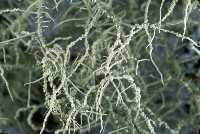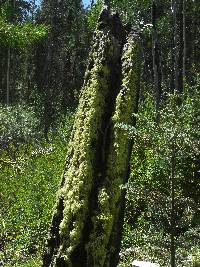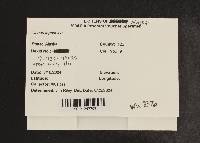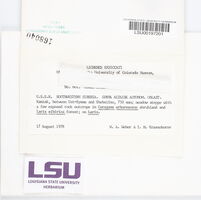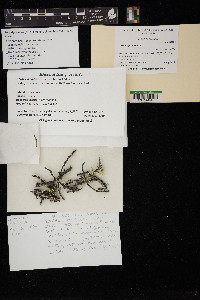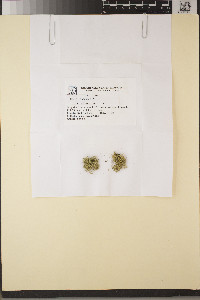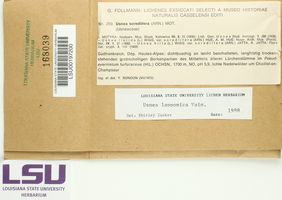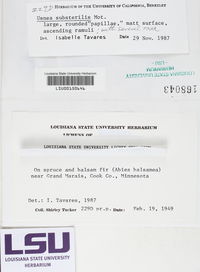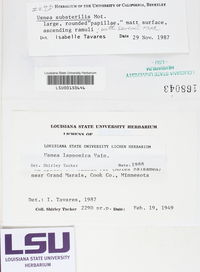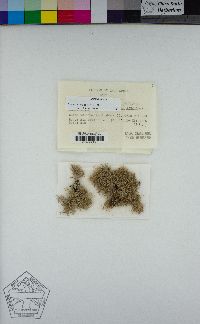
Consortium of Lichen Herbaria
- building a Global Consortium of Bryophytes and Lichens as keystones of cryptobiotic communities -
- Home
- Search
- Images
- Species Checklists
- US States: O-Z >
- US National Parks
- Central America
- South America
- US National Parks
- Southern Subpolar Region
|
|
|
|
Family: Parmeliaceae
[Usnea barbata var. perplexans (Stirt.) Vain., moreUsnea florida var. perplexans (Stirt.) Vain., Usnea lapponica Vain., Usnea sorediifera var. substerilis (Motyka) Keissl., Usnea substerilis Motyka] |
Nash, T.H., Ryan, B.D., Gries, C., Bungartz, F., (eds.) 2007. Lichen Flora of the Greater Sonoran Desert Region. Vol 3. Thallus: shrubby to subpendant, 2 to 12 cm long, forming dense erect to subpendant tufts branching: anisotomicdichotomous basal part: concolorous with the branches, to distinctly blackened branches: cylindrical to irregular, inconspicuously segmented; lateral branches: not narrowed at point of attachment segments: terete and ±cylindrical, sometimes slightly swollen, foveoles or transversal furrows often present papillae: usually numerous especially on main branches, verrucous to cylindrical tubercles and fibercles: generally absent fibrils: unevenly distributed soralia: deeply excavate, tearing off the cortex around the soralia, as large as the branches when mature, often reaching the central axis and encircling the branches, ±widely spaced and usually not confluent, arising initially on the cortex; soredia: generally farinose isidiomorphs: always absent Apothecia: not seen cortex: thin (5-7%) medulla: thick, lax to dense axis: thin to moderately thick Spot tests: medulla K+ yellow turning dark red (or deep yellow), C-, KC-, P+ orange or K-, C-, KC-, P+ deep yellow Secondary metabolite: salazinic acid (major) or psoromic acid (major), respectively relative to spot tests. Substrate and ecology: on bark, especially on Abies spp., Pinus spp., Picea spp, and Quercus spp., usually in mixed conifer forests, between 2300 and 3400 m World distribution: holarctic, mainly in continental areas Sonoran distribution: common at upper elevations in Arizona and extending to Chihuahua, rare in coastal areas of southern California and Baja California. Notes: For differences between Usnea lapponica and U. fulvoreagens, see under the latter species. Nash, T.H., Ryan, B.D., Gries, C., Bungartz, F., (eds.) 2007. Lichen Flora of the Greater Sonoran Desert Region. Vol 3. Thallus: shrubby, forming rather dense erect tufts, 2 to 12 cm long branching: anisotomic-dichotomous basal part: concolorous with the branches to distinctly blackened branches: irregular, inconspicuously segmented; lateral branches: not narrowed at point of attachment segments: terete and ±cylindrical, sometimes slightly swollen; transversal furrows: often present papillae: usually numerous especially on main branches, thick and verrucous tubercles and fibercles: generally absent fibrils: unevenly distributed soralia: slightly tuberculate to slightly excavate but remaining superficial, as large as the branches when mature, sometimes ±encircling the end of branches, ±circular, ±widely spaced and usually not confluent, arising initially on cortex; soredia: generally granulose isidiomorphs: rare, only on young soralia, never on mature ones Apothecia: not seen cortex: thin to moderately thick (4-7%), dull to slightly shiny medulla: moderately thick, dense to compact axis: moderately thick Spot tests: medulla K± yellow turning dark red, C-, KC-, P± orange; K-, C-, KC-, P- Secondary metabolites: usnic, salazinic (major), ±barbatic (minor), ±4-O-demethylbarbatic (minor), ±caperatic (minor), ±lobaric (minor) acids or usnic acid alone. Substrate and ecology: on bark (mainly Quercus spp., Pseudotsuga spp., Pinus spp., Abies spp., Picea spp.) mainly in montane forests between 1900 and 3300 m, rarely coastal in Quercus woodland between 600 and 800 m World distribution: circumpolar, mainly in continental areas Sonoran distribution: mountains of Arizona, southern California and Baja California. Notes: Usnea substerilis is closely related to U. lapponica and is frequently mixed with this species, which has deeply excavate soralia often reaching the central axis and torn off the cortex around the soralia and never produce isidiomorphs. Usnea diplotypus can also be confused with U. substerilis, but the former species has punctiform soralia and usually abundant isidiomorphs on young and mature soralia. However, in U. diplotypus, the punctiform soralia often fuse together and then appear like large soralia making it difficult to separate both species, especially when U. diplotypus has few isidiomorphs. For differences from U. ammannii, see under that species. |
Powered by Symbiota




